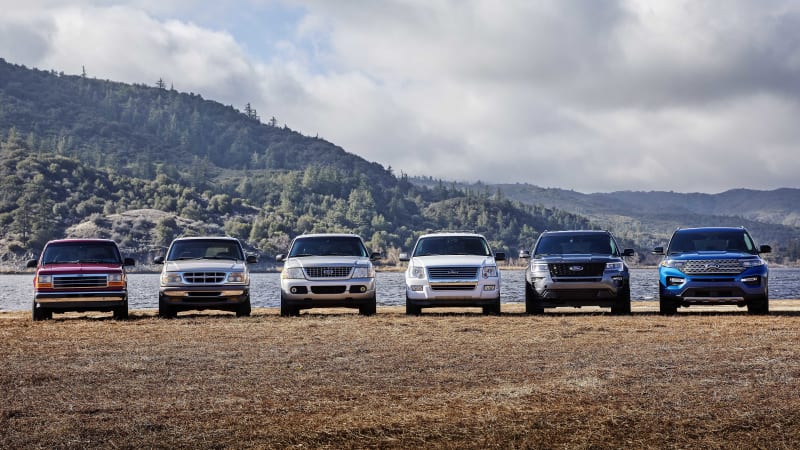A Legacy of Adventure: The Ford Explorer’s Evolving Body Styles
The Ford Explorer, a name synonymous with rugged adventure and family-friendly functionality, has seen its fair share of transformations over its nearly three-decade-long lifespan. From its humble beginnings as a boxy, truck-based SUV to its sleek, car-like evolution, the Explorer has constantly adapted to changing market demands and consumer preferences. This article delves into the fascinating evolution of the Explorer’s body style across its generations, highlighting the defining features and innovations that have shaped this iconic vehicle.
First Generation (1991-1994): The Birth of an Icon
The Ford Explorer’s story begins in 1991, when it debuted as a two-door, truck-based SUV. Sharing its platform with the Ford Ranger, the first-generation Explorer showcased a rugged, boxy design with a prominent grille and square headlights. Its high ground clearance, four-wheel drive system, and spacious interior quickly made it a popular choice for outdoor enthusiasts and families alike. While the original Explorer was only available in a two-door configuration, a four-door version was introduced in 1991, further expanding its appeal.
Second Generation (1995-2001): Refining the Formula
The second generation of the Explorer, launched in 1995, refined the original formula while retaining its core strengths. The body lines were softened, with a more rounded front end and flowing curves. The interior received a significant upgrade, featuring a more comfortable and spacious cabin. This generation also introduced the iconic "Eddie Bauer" trim level, emphasizing luxury and comfort, and saw the addition of a Sport model, designed for a sportier driving experience.
Third Generation (2002-2005): A New Era of Refinement
The third generation Explorer, introduced in 2002, marked a significant shift in the vehicle’s design philosophy. It moved away from its truck-based roots and embraced a more car-like platform, resulting in a smoother ride and improved handling. The exterior design became more aerodynamic, with a sloping roofline and rounded edges. The interior was further refined, featuring higher-quality materials and a more modern dashboard layout. This generation also saw the introduction of a new V8 engine option, providing increased power and performance.
Fourth Generation (2006-2010): Embracing Modernity
The fourth generation Explorer, launched in 2006, continued the trend of refinement and modernization. The exterior design was updated with a more aggressive front end, featuring a larger grille and more pronounced headlights. The interior received a significant overhaul, featuring a more driver-centric layout and a range of technological advancements, including a navigation system and a rear-view camera. This generation also saw the introduction of a new EcoBoost engine, offering improved fuel efficiency without compromising performance.
Fifth Generation (2011-2019): A Bold New Direction
The fifth generation Explorer, launched in 2011, marked a radical departure from its predecessors. The new model adopted a more car-like design, with a sleek and sophisticated exterior. The interior was transformed with a luxurious and technology-driven design, featuring a large touchscreen infotainment system and a range of advanced driver assistance systems. The fifth generation Explorer also introduced a new Sport trim level, featuring a more aggressive design and a powerful turbocharged V6 engine.
Sixth Generation (2020-Present): A New Chapter in Exploration
The sixth generation Explorer, launched in 2020, builds upon the success of its predecessor while introducing a host of new features and technologies. The exterior design is more refined and modern, with sharper lines and a more sculpted profile. The interior features a high-tech dashboard with a large touchscreen infotainment system and a range of advanced driver assistance systems. This generation also offers a hybrid powertrain option, providing improved fuel efficiency and reduced emissions.
The Explorer’s Legacy: A Journey of Adaptation
The Ford Explorer’s journey through generations is a testament to its ability to adapt to changing market demands and consumer preferences. From its rugged, truck-based roots to its sleek, car-like evolution, the Explorer has consistently offered a compelling blend of practicality, performance, and comfort. Each generation has introduced innovations and refinements, shaping the Explorer into the versatile and capable vehicle it is today.
The Explorer’s Enduring Appeal
The Ford Explorer’s enduring appeal lies in its ability to cater to a wide range of needs and lifestyles. Whether it’s a family seeking a spacious and comfortable vehicle for daily commutes and weekend adventures, an outdoor enthusiast looking for a capable off-road companion, or a driver seeking a sporty and stylish SUV, the Explorer has something to offer.
Looking Ahead
As the automotive industry continues to evolve, the Ford Explorer will undoubtedly continue to adapt and innovate. With its focus on technology, safety, and sustainability, the Explorer is poised to remain a leading contender in the ever-growing SUV segment. As the Explorer embarks on its next chapter, it promises to continue its legacy of adventure and innovation, offering a compelling blend of functionality and style for generations to come.










